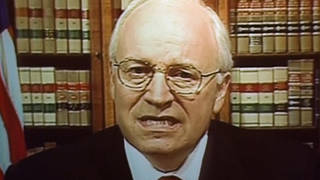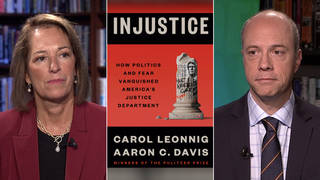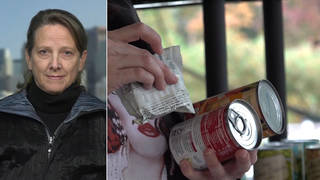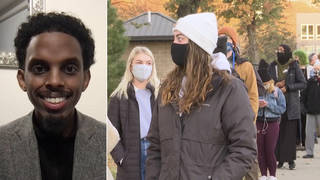
Mary Mapes, longtime television news producer and reporter who worked for CBS for fifteen years, tells the story that brought down CBS Evening News anchor Dan Rather and prompted CBS to force out four of its top journalists–including Mapes. In the report, Rather charged that President Bush had received preferential treatment in the National Guard in the early 1970s. [includes rush transcript]
We look at the story that brought down CBS Evening News anchor Dan Rather and prompted CBS to force out four of its top journalists. On September 8th, 2004, the Wednesday edition of 60 Minutes aired a report critical of President Bush’s service in the National Guard. In the report, Dan Rather charged that President Bush had received preferential treatment in the National Guard in the early 1970”s and used as evidence copies of memos that had been provided to the network by a confidential source.
Almost immediately, the validity of the memos and the credibility of the source came under attack. The source turned out to be retired Texas National Guard officer, Bill Burkett.
Initially, Dan Rather defended the story but then 12 days later, Rather apologized on the national CBS Evening News broadcast for what he called a mistake in judgment.
- CBS News, September 20, 2004.
On that same broadcast, Rather played an interview he had conducted with Bill Burkett just days before.
- Dan Rather interviewing Lt. Col. Bill Burkett, September 20, 2004.
Also in that broadcast, Rather announced that CBS was convening an independent panel to investigate the controversy, and that the network would make the findings public. The investigation was headed up by the CEO of the Associated Press Louis Boccardi and former U.S Attorney General Dick Thornburgh who had served in the Presidential administrations of Ronald Reagan and George Bush Senior.
In January of last year CBS released the findings of the investigation and promptly fired four producers involved with the story, including the lead producer, Mary Mapes. Dan Rather resigned from his anchor position a few months later.
Mary Mapes is a long time television news producer and reporter who worked for CBS for 15 years. In 2004, just a few months before the Texas National Guard story aired, she uncovered the photos of torture at Iraq’s Abu Ghraib prison bringing worldwide attention to the practices there.
Mapes has always stood by the National Guard story and maintains that the documents in question were never found to be false. She condemned the CBS investigation as politically biased and has said that she was fired because the Chief Executive of Viacom, which is the corporate parent of CBS, feared regulatory retaliation by the Bush administration. CBS maintains that Mapes was fired because of faulty reporting. Mary has written a book about her experience titled, “Truth and Duty: The Press, The President and the Privilege of Power.”
- Mary Mapes, former CBS producer. Author of “Truth and Duty: The Press, The President and the Privilege of Power.”
Transcript
AMY GOODMAN: Mary Mapes has written a book about her experience. It’s called Truth and Duty: The Press, the President, and the Privilege of Power. She joins us in our Firehouse Studio. Welcome to Democracy Now!
MARY MAPES: Thank you.
AMY GOODMAN: Well, this is part one of our interview; but, I’d like you to just lay out the anatomy of this story. How did you first learn about these documents?
MARY MAPES: Well, I — first of all, I’ve lived in Texas for 16 years, so this was a story that was sort of ongoing for me in a number of ways. For five years prior to airing the story in September, 2004, I had been on and off of the Bush story quite a bit. It’s very common knowledge in Texas what had been happening in the Texas National Guard; and the Texas Air National Guard during the 1960’s and 70’s was really not the crackerjack military outfit we think about when we think about national guard units now. We have guard units in Iraq now. At one point, I know, about 40% of the troops in Iraq were national guard and reserve folks. This is a much different breed of cat than we had back in the sixties and seventies, where we sort of in Texas with the national guard had units that really did not see active duty, that one person described to me as '”F-Troop” with planes,' and (if you remember the old, silly military show) — but — I mean, there were good and valuable people there, but there was an awful lot of patronage and privilege that determined who got in and who got out. So this is very common knowledge in Texas. It’s sort of the rest of the country, I think, that struggles with the reality of what happened there. So, I knew this. I developed sources over a five-year period. We had looked at doing a story, talked about it a couple of other times, and always felt (or my bosses felt) we didn’t have something new, you know; we didn’t have something that put it over the top. When we ran the story in September, 2004, I had two new things: I had the documents, and I had the first-ever interview — sit-down interview — with former Lieutenant Governor Ben Barnes. He’d never sat down in front of God and everybody and a TV camera and answered questions about what he had done to get Bush in. so I had those things.
AMY GOODMAN: Explain who Ben Barnes was.
MARY MAPES:Ben Barnes was sort of a Texas political wunderkind. He became the Speaker of the House in I think 1966 when he was about 24 years old. Democrat, as all of Texas was at that time. But this was — Texans are, you know, not just political, they’re realists; and so there was a lot of bipartisan back scratching and favoritism, and Barnes helped a number of people get into the Texas National Guard at that time, which was what was happening with the wealthy and the privileged and the well-connected; they were being funneled into safe guard units as opposed to going to Vietnam where, you know — which was a war that was essentially fought by the young and the poor.
JUAN GONZALEZ: So when you finally — you’d been working on this for many months, and then what finally brought it together to cause you and “60 Minutes” to decide to do a show on it?
MARY MAPES: Well, two things. One was Barnes agreeing to do the interview; the other was getting the documents. I would say early in late spring, probably of 2004, about in April I read the Abu Ghraib story and immediately after that I started hearing about documents that were floating around Texas; and you have to understand, sort of the political grapevine in Texas, which is a wonder to behold — both Democrat and Republican — and the power of that grapevine; and there were reporters from really all over the country stampeding around Texas trying to get these documents. Vanity Fair had someone there, the New York Times was there, there was a number of freelance folks there, and I was there, and I wanted them. I felt that we’d put in the time and I wanted — Whether they were a political dirty trick that some genius had masterminded. I thought that was a fabulous story, too, or if they were real. I thought it was a fascinating story. And I’ve always thought the Bush guard story was really the Rosetta Stone of George W. Bush; it’s who he is, what his character’s about, how he came up, how he came to be, and what’s at his core.
AMY GOODMAN:So, how’d you hook up with Burkett?
MARY MAPES: Oh, in a roundabout way through a number of different sources, and then finally talking directly and through intermediaries and convincing him to sit down and meet with us. And I had begged him to bring me an example. And Burkett had these, I believed, because he was a very likely person to get handed something. He was already in the public eye. He’d already come out against Bush. He had nothing to lose in the way that a new person might. And I thought he was a very likely source to get handed something by somebody. So, it made sense to me in that way. I never did think Burkett had been the original source of the documents. I thought he was just an intermediary.
AMY GOODMAN:What did the documents say?
MARY MAPES: There were six pieces of paper. I got two the first day I met with Bush. They basically —
AMY GOODMAN: That you met with Burkett.
MARY MAPES: I’m sorry, yes. Right. Bush really won’t meet with me, I can tell you. Burkett gave me two that showed — They were written by — purported to have been written by — Lieutenant Colonel Jerry Killian. They were typed pieces of paper. Killian had been the head of the 147th fighter interceptor squadron, known as 'the champagne unit,' which is what Bush was assigned to in Houston in 1970. It showed that in 1972, when Bush had walked away from the Guard in April, that Killian had tried to get him back, had ordered him to take a physical, had worked with him to try to get him to show up for alternative guard duty, and then had been pressured — Killian had been pressured by his superiors to fill in paperwork that would get Bush off the hook for having been gone for a year and a half. So, I thought they were tremendously provocative, very important; and I knew enough about the record to know where they fit in if they were real. I told Burkett when I first saw them that my greatest fear was that this was a political dirty trick, and I did it in part to see his reaction to my saying that, and I thought he looked shocked. I don’t think he is a forger, and I also think if these documents were forged they were done by a better forger than did the Niger documents.
JUAN GONZALEZ: Well, the — obviously, when the doc — you had had the documents vetted by some experts and afterwards there were questions as to whether those experts had actually said that they were — they were originals or not, and — Talk — Walk through — us through what happened with the experts when you first talked to them and then after the show broadcas.
MARY MAPES: I — Well, as soon as I knew I had the documents (I had two documents to start with and I got four a couple of days later, so I had a total of six) — soon as I found out I had the documents in my hot little hand we started lining up document analysts. One of the first things I learned about document analysis is that it is a subjective sort of art-slash-science. It’s not D.N.A. testing. You can not look at a copy of a document, which is what these are, and determine absolute authenticity as to the date that these were typed. Now, in an original document, you can actually do an ink D.N.A. test and see when that ink was manufactured. I didn’t have that option. So I had to have document analysts who would look at these things and say: Yeah, the typeface looks right, you know, all the physical aspects of this document looked right. And then I had my own team that went through, vetted the documents for accuracy as to dates and names and personalities, and, you know, when there was a reference to an air force manual paragraph and page to go back and get the 1972 manual and make sure that that was exactly as it should be; and then I meshed them all with the official record. And I, frankly, thought I was going to find a point where they bumped up against each other and they didn’t work, and it’d be clear to me that this was, you know, some craftsmanship on someone’s part; and I couldn’t find that. So, I had two analysts, my most experienced analysts, telling me: These are good to go; and these are people with more than 30 years’ experience. I had two other analysts who told me — one told me I need an original to make a judgment, and the other one believed — she had some problems with it; and I went with the two more experienced analysts.
AMY GOODMAN: So, you went with the story. Dan Rather then goes to the White House with these documents.
MARY MAPES: Right. Wednesday morning, the morning the story aired.
AMY GOODMAN: Does an interview.
MARY MAPES: Does an interview with Dan Bartlett.
AMY GOODMAN: Bartlett does not contest the documents.
MARY MAPES: No. Not at all.
AMY GOODMAN: What does he say?
MARY MAPES: He said that — what I thought was wildly amusing at the time and I stopped laughing about by the next day. He said that he believed that the documents fully supported Bush’s contention that he had permission to go, because Killian, in these documents, was acknowledging that he had discussed with Bush that Bush wanted to go and work on a political campaign in Alabama. So, he did not, and he was asked point blank whether you’re contesting — whether he was contesting the authenticity, and he said, “No, no, not at all.” Then the White House put the documents — even prior to our story running, the White House put the documents up on their website. And I think that was a way of calling in the dogs, of getting political activists and operatives to, you know, get their powder dry, to get ready to start attacking, which was what they did when the story aired that night.
JUAN GONZALEZ: When you say put they them up on their website, what reason did they give to suddenly put that up on the website?
AMY GOODMAN: Before your story ran.
MARY MAPES: Right. They didn’t give a reason.
AMY GOODMAN: So —
MARY MAPES: I mean, they certainly don’t owe us any explanation. That’s how they felt —
AMY GOODMAN: They didn’t say they were fake?
MARY MAPES: No. They said these are documents that are going to be used in the story; but what I think it allowed them to do, was to pass these documents on to operatives with no fingerprints, with no actual, you know, overt passing them on to someone specific.
AMY GOODMAN: So, all Hell breaks loose after the piece airs that night.
MARY MAPES: Yeah, in fact, by the time our story was off the air on the west coast, I mean, the moment it went off the air, it was — it went nuts. From attacks on the authenticity of the documents, typeface and proportional spacing and all kinds of stuff that no sane person would obsess themselves with.
AMY GOODMAN: But to show — talk about the docu —- the authenticity of the documents. What were the websites -—
MARY MAPES: Right, just to attack.
AMY GOODMAN: — the websites that went after you?
MARY MAPES: Little Green Footballs, and I was just noticing Little Green Footballs is apparently a favorite today on this broadcast, because one of your previous guests had mentioned racist — what he felt were racist postings. I was shocked at some of the postings on Little Green Footballs. Little Green Footballs is a very, very proactive, I think far right — You know, I grew up on a farm with a lot of conservatives around me, and —- good people who would never talk and attack this way. And I thought the attacks were vicious and pointed and sexist and -—
AMY GOODMAN: Mary Mapes, this is part one of our two-day interview with you. Tomorrow we will find out what happened when — well, when the attack began and where CBS stood and the investigation that was led by the former U.S. Attorney General Richard Thornburg. Mary Mapes is the author of Truth and Duty: The Press, the President, and the Privilege of Power . Part two tomorrow. this is Democracy Now!












Media Options